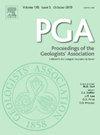Skull roof anatomy of the Early Jurassic (Toarcian) acipenseriform †Gyrosteus mirabilis Woodward ex Agassiz, from Yorkshire, England, elucidates diversity of †Chondrosteidae
IF 1.2
4区 地球科学
Q2 Earth and Planetary Sciences
引用次数: 0
Abstract
An articulated and mostly complete skull roof of the enigmatic Early Jurassic chondrosteid fish, †Gyrosteus mirabilis Woodward ex Agassiz is described from the Whitby Mudstone Formation (Toarcian) of Whitby, Yorkshire. Known since the 1830s, isolated bones attributable to this taxon are frequently found along the Whitby coast, although articulated remains are rarely reported. The fragmentary nature of Gyrosteus mirabilis, the largest non-reptilian animal from the British Lower Jurassic, has led some researchers to propose it as a subjective synonym of †Chondrosteus Egerton ex Agassiz, from the Lower Lias of Dorset, and others to suggest synonymy with the similarly massive †Strongylosteus Jaekel from the Upper Lias (Toarcian) of Germany. Here, we compare the skull roof anatomies of †Gyrosteus mirabilis with †Chondrosteus acipenseroides and †Strongylosteus hindenburgi and present new criteria to differentiate between these taxa. We find the skull roofs of Chondrosteus and Strongylosteus to be vastly different with Gyrosteus representing something of an ‘intermediate’ morphology with closer affinities to Strongylosteus. The presence of a medial parietal and rostral bones is shared between Gyrosteus and Strongylosteus but these are absent in Chondrosteus. Our results support the taxonomic validity of both Gyrosteus mirabilis and Strongylosteus hindenburgi as monotypic genera distinct from Chondrosteus acipenseroides.
来自英国约克郡的早侏罗世(Toarcian)蛇形†Gyrosteus mirabilis Woodward ex Agassiz的头骨顶解剖,阐明了†软骨steidae的多样性
在约克郡惠特比的惠特比泥岩组(Toarcian)中,发现了一种神秘的早侏罗世软骨鱼,†Gyrosteus mirabilis Woodward ex Agassiz的关节状且基本完整的头骨顶。自19世纪30年代以来,人们就知道,在惠特比海岸经常发现属于这个分类群的孤立骨骼,尽管铰接的遗骸很少被报道。来自英国下侏罗纪的最大的非爬行类动物Gyrosteus mirabilis的碎片性使得一些研究人员认为它是来自多塞特(Dorset)下利亚斯(Toarcian)的†Chondrosteus Egerton ex Agassiz的主观同义词,而另一些人则认为它是来自德国上利亚斯(Toarcian)的同样巨大的†Strongylosteus Jaekel的同义词。本文比较了†Gyrosteus mirabilis与†Chondrosteus acpenserides和†Strongylosteus hindenburgi的头骨顶解剖结构,并提出了区分这些分类群的新标准。我们发现软骨龙和圆形龙的头骨顶部有很大的不同,圆形龙代表了一种与圆形龙更接近的“中间”形态。在Gyrosteus和Strongylosteus之间有共同的内侧顶骨和吻骨,但在Chondrosteus中没有。我们的研究结果支持了奇异Gyrosteus mirabilis和hindenburgi Strongylosteus作为单型属的有效性。
本文章由计算机程序翻译,如有差异,请以英文原文为准。
求助全文
约1分钟内获得全文
求助全文
来源期刊
CiteScore
2.70
自引率
8.30%
发文量
54
审稿时长
6-12 weeks
期刊介绍:
The Proceedings of the Geologists'' Association is an international geoscience journal that was founded in 1859 and publishes research and review papers on all aspects of Earth Science. In particular, papers will focus on the geology of northwestern Europe and the Mediterranean, including both the onshore and offshore record. Following a long tradition, the PGA will focus on: i) a range of article types (see below) on topics of wide relevance to Earth Sciences ii) papers on aspects of Earth Science that have societal relevance including geoconservation and Earth management, iii) papers on palaeoenvironments and palaeontology of the Mesozoic and Cenozoic, iv) papers on aspects of Quaternary geology and climate change, and v) papers on the history of geology with particular reference to individuals that have shaped the subject. These topics will also steer the content of the themes of the Special Issues that are published in the PGA.

 求助内容:
求助内容: 应助结果提醒方式:
应助结果提醒方式:


